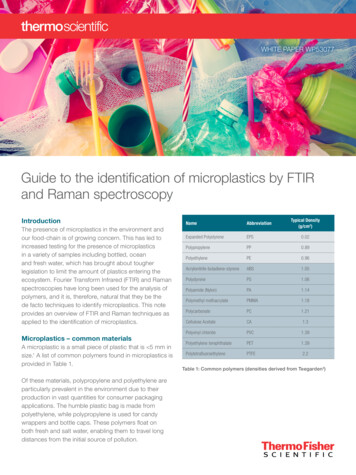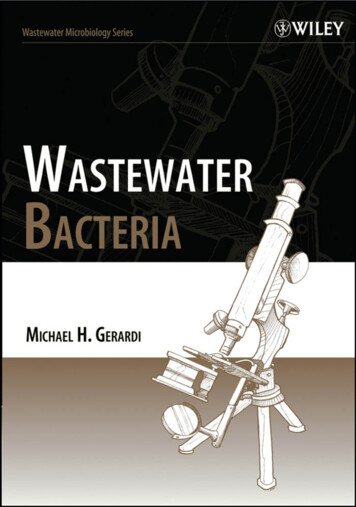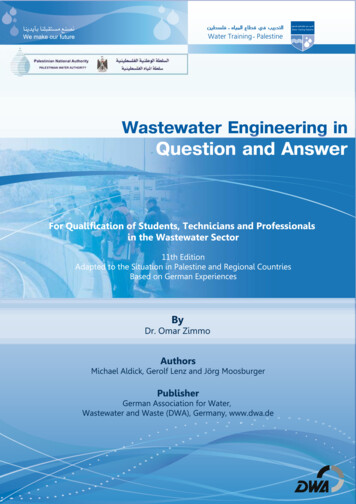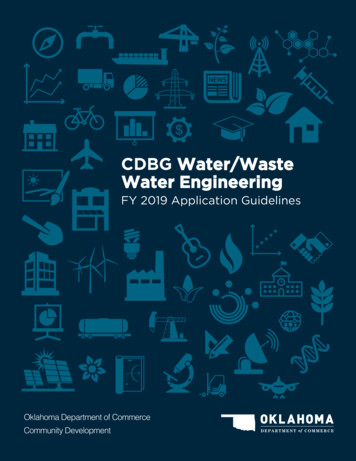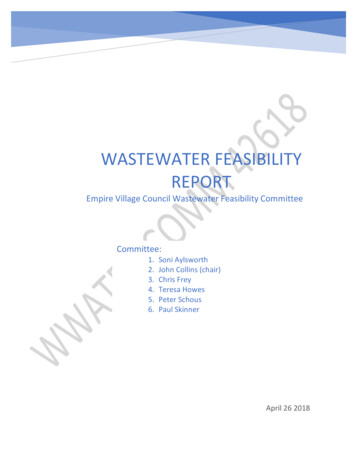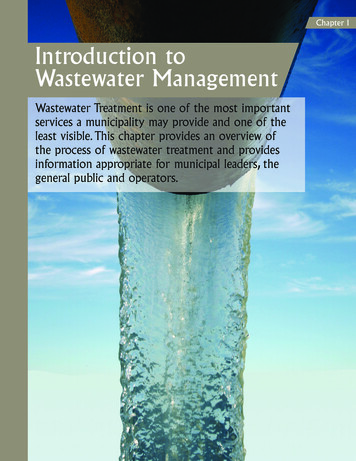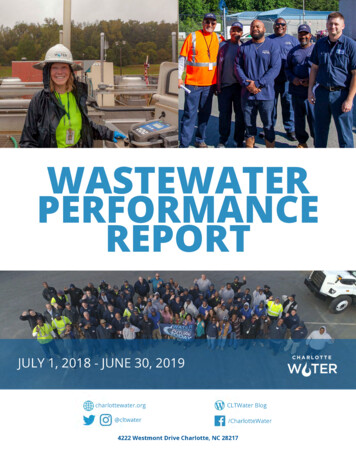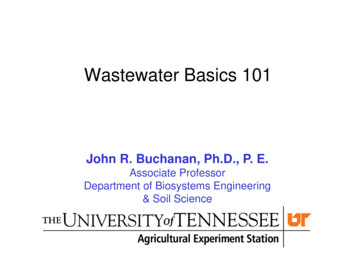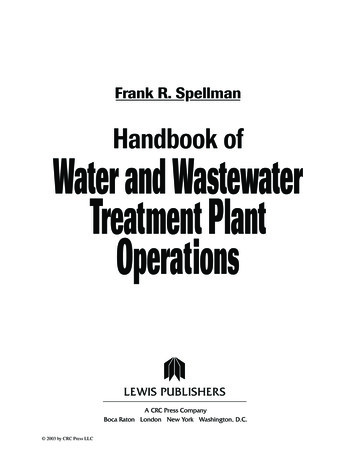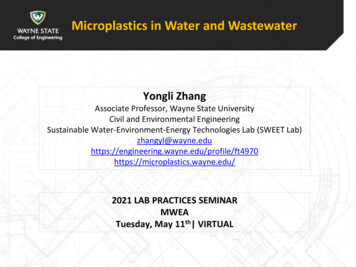
Transcription
Microplastics in Water and WastewaterYongli ZhangAssociate Professor, Wayne State UniversityCivil and Environmental EngineeringSustainable Water-Environment-Energy Technologies Lab (SWEET 1 LAB PRACTICES SEMINARMWEATuesday, May 11th VIRTUAL
Microplastics in Water and WastewaterAcknowledgmentCo-InvestigatorsDr. Baker, TracieDr. Chen, MarkDr. Kashian, DonnaDr. Miller, CarolDr. Mitra, RahuDr. Shi, WeisongProject ManagerTreemore-Spears,LaraCollaboratorsBeloskur, MichelleBrasie, AnneBobryk, ChrisBusch, AndreaStudentsDunne, MichaelDarabi, SamNorton, JohnDiehl, AllisonPutala, VickiKim, JunyeolLewandowski, Ashton Sexton, KathleenWalls, CliffordMirza, RayyanWeyhrauch, JonathanMobasser, ShariatWu, EricNIEHS P30 ES020957CONTRACT NO. 1904710GLPF 1151
Public concerns about microplasticsSource: Law and Thompson, 2014.They are found in Oceans Freshwater Drinking water(tap water andbottled water) Food Drinks Human
Public concerns about en/content/microplastic-intable-salt/Source: Pivokonsky et al., 2018Treated drinking water: 300 – 500 particles/LImages: Marine National Park Operation Center Trang 3 / -now-available-with78-types-of-plastic-inside/
Public concerns about microplasticsSource: Developed by the project team of “Smart Management ofMicroplastic Pollution in the Great Lakes” led by Wayne State University
Where microplastics come from? Primary microplastics: plastics manufactured to be ofmicroscopic size.- Health and beauty products- Glitter- Paintings / coatings / inks- Industrial abrasivesSecondary microplastics: degraded from large plastics debrisor torn off from wear and tear (clothes and tires).Source: Ocean Voyages Institute/GregYoder, APSource: WSU, YongliZhang
How microplastics enter into the environment?Point and nonpoint sourcesSludgeWashing waterLost fishing gearand sludge- Plastic debris- Plastics fromwear and tearRunoffPotential pathways of microplastics entering into the environmentSource: Kim et al., “Occurrence and Removal of Microplastics in Drinking Water Systems” (book chapter under preparation).
Microplastics in WaterSource: Koelmans et al., 2019, Water Research.
Microplastics in Water“There is a need to betterunderstand microplasticsoccurrence throughout thewater supply chain, usingquality-assured methods todetermine the numbers,shapes, sizes, compositionand sources of microplasticsand to better characterizethe effectiveness of watertreatment.” WHO, 2019.
Removal of Microplastics by Water andWastewater Treatment ProcessesEstimated microplastic particles flow in wastewater treatment plant withprimary, secondary and tertiary treatment processes (Sun et al., 2019)
Removal of Microplastics by Water andWastewater Treatment Processes45-59%70-90%10-30%Small MPs (1–5 μm) increase?Estimated microplastic particles flow in water treatment plant
Removal of Microplastics by Water Treatment ProcessesScreening: remove large plastic debrisCoagulation/flocculation/sedimentation: low removal efficiency- 0.1% to 16.5% of removal (Zhang et al., Science of the Total Environment (2020)).- 5% of removal at regular coagulant dosage (Ma et al., Chemical Engineering Journal (2019)).- 41% - 55% of removal in water treatment plants (Wang et al., Science of the Total Environment (2020)).Filtration: much more efficient for microbeads and fragments- 86.9 % to 99.9% (microplastics 100 um) (Zhang et al., Science of the Total Environment (2020)).- 80% (microbeads), 70% (fragments), 50% (microfibers) (Pivokonsky et al., Science of the TotalEnvironment (2018); Wang et al., Science of the Total Environment (2020))Other process: dissolved air flotation (DAF)?- 83% (with flotation) compared to 70% - 81% (without flotation) (Pivokonsky et al., Science of the TotalEnvironment (2018))
Water Source Matters: Surface WaterRaw water: 1500 – 7000 particles /LTreated drinking water: 300 – 500 particles/L
Water Source Matters: Ground WaterRaw water and treated drinking water: 0 – 7 particles/m3
Size of Microplastics Matters:Importance and Challenges of Going SmallHard to be detectedOther methods (filtration FTIR/micro Raman)- Micro Raman ( 1 um)- Fourier-transform infrared spectroscopy (FTIR) ( 20 um)Challenges- Time consuming- Labor intensive- Not able to detect small microplasticsUnderestimate microplastic ult/files/publicationsfiles/noaa microplastics methods manual.pdfSource: Koelmans et al., 2019, Water Research.
Size of Microplastics Matters:Importance and Challenges of Going SmallHard to be removedSource: Pivokonsky et al., 2018Source: Wang et al., 2020
Size of Microplastics Matters:Importance and Challenges of Going SmallHard to be removedNumber of microplastics,particles/LSize distribution of microplastics in drinking water300250200150100What about nano-sizemicroplastics?500-50The number of microplasticsincreases by following a powerlaw along with the decreasedsize of microplastics.50 - 10010 - 505 - 10Size of microplastics, umOriginal data source: Pivokonsky et al., 20181-5
Size of Microplastics Matters:Importance and Challenges of Going SmallHard to be removedRemoval Efficiency ofFiltration (%)1101009080180 nm1 um10-20 um45-54 um 106-125 umParticle SizeZhang et al., Science of the Total Environment (2020)
Size of Microplastics Matters:Importance and Challenges of Going SmallEasy to enter food and water supplyPotential ecological and human health risks- Translocate across the gut barrier- Accumulate in tissues- Perturb gut microbiome- Induce inflammation,neurodegeneration and motordysfunction- Alter transcriptome- Carry other contaminantsPedersen et al., Environmental Pollution (2020)
Microplastics in Water- Ongoing research at Wayne State UniversityOur Objectives Understanding the source, fate and transport of emerging contaminants in naturaland engineering water systems and the consequential impact on ecological andhuman heath. Developing technologies for high throughput detection of small microplastics (nmto 100 um) Reducing microplastic pollution sources, through a microplastic reductioncampaign and mitigation initiative supported by the development of web-basedtools that can be used by community leaders to tackle microplastic and plasticproblems.Funded Research Projects Smart Management of Microplastic Pollution in the Great Lakes (funded by GreatLakes Protection Fund #1151) The Occurrence and Fate of Microplastics in Water and Wastewater TreatmentSystems (funded by Great Lakes Water Authority, CONTRACT NO. 1904710) The Occurrence of Microplastics in Drinking Water and the Consequential Impact onHuman Health (funded by WSU CURE Center, NIEHS P30 ES020957)
Microplastics- Ongoing research at Wayne State UniversityCollaboration Multi-disciplinary investigators Water Industry and WaterAuthority Business Partners Communities Non-profit Organizations Universities K-12 schoolsDevelopment ofdetection technologiesCommunity engagement and mitigation campaign:web-based tools to tackle microplastic issues- A community-based assessment tool forestimating micro- and macro-plastic emissions- Targeted mitigation- Effective community engagementPublic education
Microplastics- Ongoing research at Wayne State UniversityWe are developing WEB-BASED TOOL KITS that can be used by communities to tacklemicroplastic/plastic problems to keep our water clean.If you are interested in learning more about our projects and tool kits, please contact Dr.Yongli Zhang zhangyl@wayne.edu or visit our project website microplastics@wayne.edu
Microplastics in Water There is a need to better understand microplastics occurrence throughout the water supply chain, using quality-assured methods to determine the numbers, shapes, sizes, composition and sources of microplastics and to better characterize the effe
